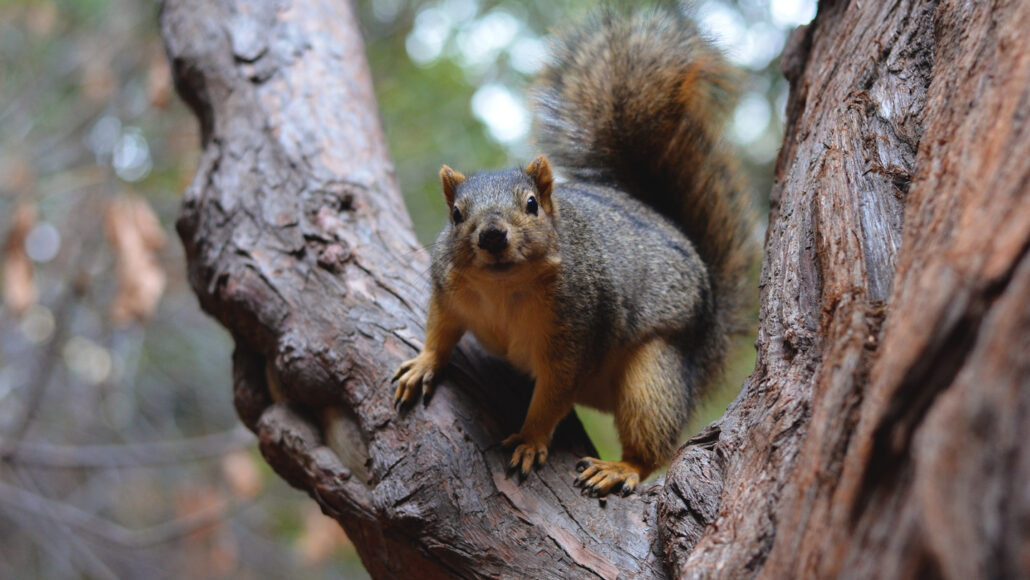Squirrels use parkour tricks to leap from branch to branch
The rodents account for tree limb flexibility and distance as they vault through the forest

Fox squirrels (one pictured) are furry little acrobats that can jump quickly between tree limbs. New research shows how these rodents land their leaps.
Judy Jinn, UC Berkeley
For squirrels, advanced acrobatics are a matter of survival. When leaping between bendy branches that sway with the wind, the smallest error could spell death. New videos reveal how squirrels successfully leap from branch to branch.
These rodents make split-second calculations to plan jumps. Those decisions account for both branch stiffness and the distance between tree limbs. For super tricky jumps, squirrels improvise moves in midair. Researchers share these findings in the August 6 issue of Science. They find the squirrels’ tricks are similar to the stunts pulled by parkour athletes — people who scale walls, flip over railings and jump between buildings.
This is “a great example of how cool ‘normal’ animals can be,” says Michelle Graham. She wasn’t involved with the research. She does, however, study biomechanics at Virginia Tech in Blacksburg. “We’ve all seen squirrels do crazy stuff in nature,” Graham says. “But no one ever pays any attention to it.”
Unless, that is, you’re like Nathaniel Hunt. He has been awed by watching squirrels flash through trees for years. “Tree canopies are incredibly challenging environments to navigate,” says Hunt. He’s an integrative biologist at the University of Nebraska Omaha. To jump between bendy branches, a squirrel must judge how far it has to go and when to leap. Jumping from the base of a branch offers a sturdy foundation. But the squirrel may not be able to clear the length to the next branch. Moving toward the tip of the branch shrinks that distance. But that tip may be too flimsy to launch from. Hunt wondered, “How are they sensitive to that trade-off?”
To find out, he and his colleagues designed an artificial-forest obstacle course. Then, the team coaxed free-ranging fox squirrels (Sciurus niger) to run and jump through the course. The researchers rewarded their furry test subjects with peanuts.
First, the squirrels learned to leap from artificial branches across a gap. Some branches were stiffer than others. On the other side of the gap was a prize: a basket of peanuts attached to a landing peg. High-speed video captured the jumps from launch to landing. A total of 12 squirrels completed 96 leaping trials.
The squirrels leaped from bendier branches earlier. They may have been trying to maximize their jumping force. But that strategy also increased the distance that the animals had to clear.
To explore this behavior, the researchers ran computer models of squirrel jumps. One version of the model matched real squirrel behavior. And here, branch flexibility was six times more important than gap length for determining when a squirrel would jump. “We were surprised to see squirrels weighing both of these things … but in different amounts,” Hunt says.
The researchers took their obstacle course to the next level for five squirrels. Here the branches were more flexible and the gap between them widened. The squirrels’ first leaps were less than graceful. None fell, but most had clumsy landings. They grasped the landing peg with their front paws and swung around to pull themselves up. (Ideally, the squirrels would land neatly on all fours.) But squirrels got the hang of it within five tries, Hunt says. It just required adjusting their starting speed.
Such quick learning could come in handy if squirrels often cross the same tree limbs. That “might explain how they move so fluidly and rapidly” across particular branches, Hunt explains. “They’ve already learned what they need to know about that branch.”
The squirrels surprised the researchers in other ways too. For longer jumps — or those that required landing higher or lower than the starting point — squirrels got fancy. Many rotated midair and used their legs to “jump” off a nearby wall. This parkour-style maneuver helped them land difficult jumps. Squirrels also used parkour to slow down if they were coming in too hot to a landing. “It’s an additional point of control,” Hunt says.
For many tree-dwelling animals, “jumping between limbs is such a common thing,” Graham says. “Yet we so frequently only study it in pieces.” For instance, researchers might look at the launch but not the landing. This study gives a more complete view, she says. It’s “really interesting” that squirrels care more about branch stiffness than gap distance in planning jumps, she says. “I don’t know that I would’ve guessed that.”







